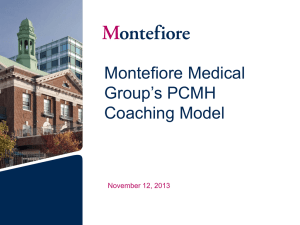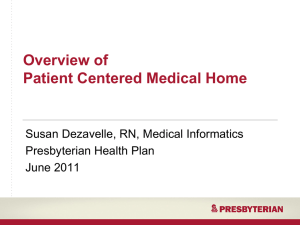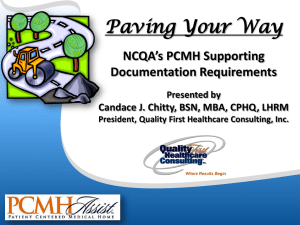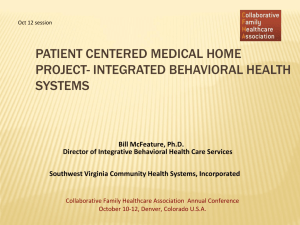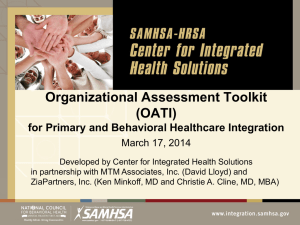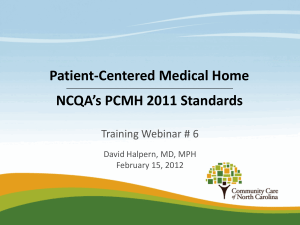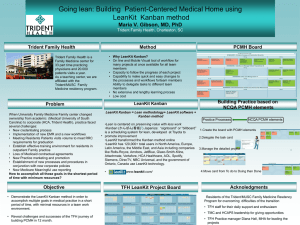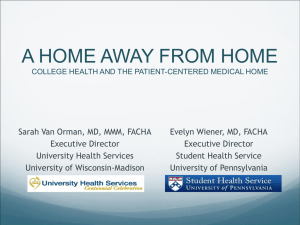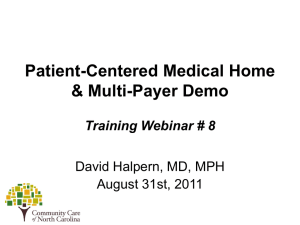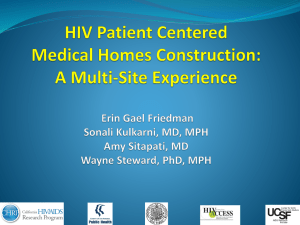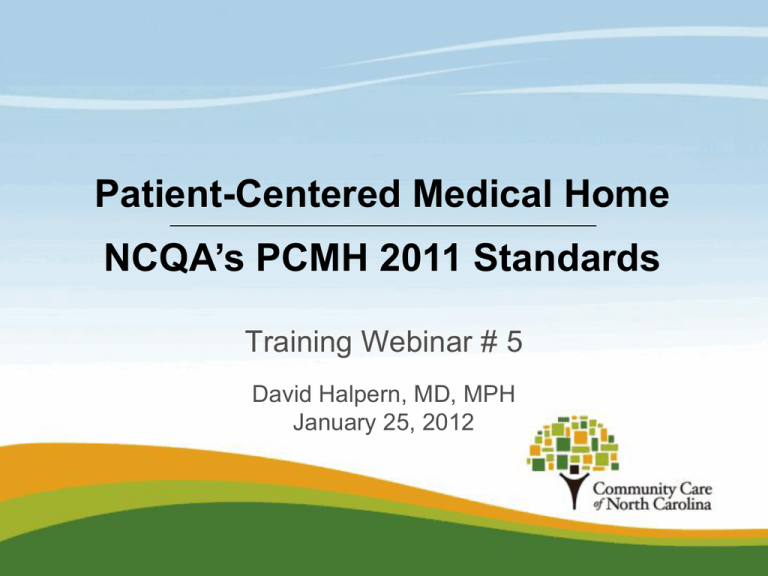
Patient-Centered Medical Home
NCQA’s PCMH 2011 Standards
Training Webinar # 5
David Halpern, MD, MPH
January 25, 2012
Legal Disclaimer
© Copyright 2011 North Carolina Community Care Networks,
Inc. All rights reserved. The content set forth herein is made
available on an “as is” basis without representation or warranty of
any kind and solely for use and distribution by primary care
physicians, without modification and only so long as the content of
this footer is reproduced on every copy thereof, in connection with
the internal activities of their respective not-for-profit organizations to
secure NCQA recognition as patient-centered medical homes. All
other uses of or modifications to the content set forth herein without
the prior express written approval of North Carolina Community
Care Networks, Inc. are strictly prohibited. Works copyrighted by
third parties and included herein are used with the permission of the
respective copyright owners in each case.
Acknowledgements
Let’s Review
• Standard 1 – Enhance Access &
Continuity
– PCMH1A: Access During Office Hours –
MUST PASS
– PCMH1B: After-Hours Access
– PCMH1C: Electronic Access
– PCMH1D: Continuity
– PCMH1E: Medical Home Responsibilities
– PCMH1F: Culturally and Linguistically Appropriate
Services
– PCMH1G: The Practice Team
Today’s Agenda
• Standard 2 – Identify & Manage Populations
• Standard 5 – Track & Coordinate Care
PCMH 2: Identify and
Manage Populations
Elements
• PCMH 2A: Patient Information
• PCMH 2B: Clinical Data
• PCMH 2C: Comprehensive Health
Assessment
• PCMH 2D: Use Data for Population
Management - MUST PASS
PCMH 2A: Patient Information
• Practice uses a searchable electronic system
and records data more than 50% of the time for
the following:
1. Date of birth*
2. Gender*
3. Race*
4. Ethnicity*
5. Preferred language*
6. Telephone numbers
7. E-mail address
8. Dates of previous
clinical visits
9. Legal guardian/health
care proxy
10. Primary caregiver
11. Advance directives
(NA for pediatrics)
12. Health insurance
* Meaningful Use Requirement
PCMH 2A: Patient Information
• 3 Points
• Scoring
–
–
–
–
–
9-12 factors= 100%
7-8 factors= 75%
5-6 factors= 50%
3-4 factors= 25%
0-2 factors= 0%
• Data Sources:
– Report showing percentage of all patients seen in the last
3 months, for whom each factor is complete/entered in the
electronic record. Requires numerator (patients for whom
each field is complete) and denominator (all patients seen
in last 3 months). (CHART REVIEW NOT ACCEPTABLE)
PCMH 2A: Example
This report shows
various domains
and what % of
patients have
complete
information entered
for each field.
Note: a screenshot
of the EMR is not
sufficient without a
report
PCMH 2A: Example – Factor 11
Note: a screenshot
of the EMR alone is
not sufficient
without a report
PCMH 2B: Clinical Data
• Practice uses a searchable electronic system to
record the following data:
1.
2.
3.
4.
5.
6.
7.
Up-to-date problem list of active diagnoses for 80% of patients
Allergies, including medications and reactions for 80% of patients
Blood pressure with the date of update for 50% of patients
Height for 50% of patients
Weight for 50% of patients
BMI for 50% of patients
Length/height, weight head circumference (less than 2 years); BMI
percentile (2-20); for pediatric patients for 50% of patients
8. Tobacco use status for patients 13 and older for 50% of patients
9. List of prescription medications with date of update for 80% of
patients
PCMH 2B: Clinical Data
• 4 Points
• Scoring
–
–
–
–
–
9-12 factors= 100%
7-8 factors= 75%
5-6 factors= 50%
3-4 factors= 25%
0-2 factors= 0%
• Data Sources:
– Report showing percentage of all patients seen in the last
3 months, for whom each factor is complete/entered in the
electronic record. Requires numerator (patients for whom
each field is complete) and denominator (all patients seen
in last 3 months). (CHART REVIEW NOT ACCEPTABLE)
PCMH 2B: Example – Factor 1
Note: a screenshot
of the EMR alone is
not sufficient
without a report
PCMH 2B: Example – Factor 2
Note: a screenshot
of the EMR alone is
not sufficient
without a report
PCMH 2C: Comprehensive
Health Assessment
• Practice conducts and documents a health
assessment:
1.
2.
3.
4.
5.
6.
7.
8.
9.
Age and gender appropriate immunizations/screenings
Family/social/cultural characteristics
Communication needs
Medical history of patient and family
Advance care planning (NA for pediatrics)
Behaviors affecting health
Patient and family mental health/substance abuse
Developmental screening using standardized tool (NA for adult
only practices)
Depression screening for teens/adults using standardized tool
PCMH 2C: Comprehensive
Health Assessment
• 4 Points
• Scoring
– 8-9 factors= 100%
– 6-7 factors= 75%
– 4-5 factors= 50%
– 2-3 factors= 25%
– 0-1 factors= 0%
• Data Sources:
– Report or a completed patient assessment (deidentified)
PCMH 2C: Example – Factor 6, 9
PCMH 2C: Example – Factor 4, 7
PCMH 2C: Example – Factor 1, 5, 6, 7
PCMH 2D: Use Data For
Population Management
• Practices uses patient data and evidencebased guidelines to generate lists and
remind patients about needed services:
1. At least three different preventive care
services**
2. At least three different chronic care services**
3. Patients not recently seen by the practice
4. Specific medications
** Meaningful Use Requirement
PCMH 2D: Use Data For
Population Management
• MUST PASS
• 5 Points
• Scoring
–
–
–
–
–
4 factors = 100%
3 factors = 75%
2 factors = 50%
(must-pass threshold)
1 factors = 25% (not sufficient for passing element)
0 factors = 0%
• Data Sources:
– Lists or summary reports of patients who need services
• Reports must contain at least three different immunizations or
screenings and three different acute/chronic care services
• A registry is not specifically required but will facilitate the process
– Materials demonstrating patient notification
PCMH 2D: Example – Factor 1
List of patients who have
not received pneumovax
Patient list is
blinded to
protect
confidentiality
PCMH 2D: Example – Factor 2
patient
names
and
MRNs
have
been
blinded
List of patients who have
not received appropriate
hypertensive care
PCMH 2D: Example – Factor 3
List of diabetics who
have not been seen
in past 6 months
PCMH 2D: Example – Factor 4
List of patients in the
practice taking Toprol XL
(names of patients blinded for HIPAA)
PCMH 5: Track & Coordinate Care
Elements
• PCMH 5A: Test Tracking & Follow-Up
• PCMH 5B: Referral Tracking & Follow-Up
MUST PASS
• PCMH 5C: Coordinate With Facilities &
Care Transitions
PCMH 5A: Test Tracking & Follow-Up
• Practice has documented process for and demonstrates:
1. Tracks lab tests and flags and follows-up on overdue results –
CRITICAL FACTOR
2. Tracks imaging tests and flags and follows-up on overdue results –
CRITICAL FACTOR
3. Flags abnormal lab results
4. Flags abnormal imaging results
5. Notifies patients of normal and abnormal lab/imaging results
6. Follows up on newborn screening (NA for adults)
7. Electronically order and retrieve lab tests and results
8. Electronically order and retrieve imaging tests and results
9. Electronically incorporates at least 40% of lab results in records**
10.Electronically incorporate imaging test results into records
** Meaningful Use Requirement
PCMH 5A: Test Tracking & Follow-Up
• 6 Points
• Scoring
– 8-10 factors (including factors 1 and 2) = 100%
– 6-7 factors (including factors 1 and 2) = 75%
– 4-5 factors (including factors 1 and 2) = 50%
– Fewer than 3 factors = 0%
• Data Sources:
– Process or procedure for staff and an example of how
factors 1-6 are met
– Electronic system examples for factors 7-10
PCMH 5A: Example – Factor 1
PCMH 5A: Example – Factor 1
PCMH 5A: Example – Factor 1
PCMH 5A: Example – Factor 2
PCMH 5A: Example – Factor 5
PCMH 5A: Example – Factor 7
Lab Test Order Screen
PCMH 5A: Example – Factor 8
Radiology Test Order Screen
PCMH 5B: Referral Tracking
& Follow-Up
• Practice coordinates referrals:
1. Provides specialist with reason and key information for the
referral
2. Tracks referral status
3. Follows up to obtain specialist reports
4. Has agreements with specialists documented in the record
5. Asks patients about self-referrals and requests specialist
reports
6. Demonstrates electronic exchange of key clinical information**
7. Provides electronic summary of care for more than 50% of
referrals**
** Meaningful Use Requirement
PCMH 5B: Referral Tracking
& Follow-Up
• MUST PASS
• 6 Points
• Scoring
–
–
–
–
–
5-7 factors= 100%
4 factors = 75%
3 factors = 50%
(must-pass threshold)
1-2 factors= 25% (not sufficient for passing element)
0 factors = 0%
• Data Sources:
– Reports or logs demonstrating tracking system data collection
– Documented processes with three examples
– Reports from electronic system showing frequency of information
exchange and summary of care records
PCMH 5B: Example – Factor 2
PCMH 5B: Example – Factor 2
PCMH 5B: Example – Factor 2
Patient
Name
MRN
Referring
Clinician
Reason for
Referral
Date of
Referral
Referred to
Completed?
Insurance
(Y/N & Date)
Joe Smith
12345
Halpern
Back Pain
6/16/11
Triangle
Ortho
No
BCBS-NC
Mary Jones
54321
Halpern
Colonoscopy
6/16/11
Durham GI
Yes 6/21/11
Duke
Select
PCMH 5C: Coordinate With Facilities
and Care Transitions
• Practice systematically demonstrates:
1.
2.
3.
4.
5.
6.
Process to identify patients with hospital admissions or ED visits
Process to share clinical information with hospital/ED
Process to obtain patient discharge summaries
Process to contact patients for follow-up care after discharge
Process to exchange patient information with hospital
It collaborates with patient to develop written care plan for
transitions from pediatric to adult care (NA for adults)
7. Electronic exchange of key clinical information with facilities **
8. Provides electronic summary of care for more than 50% of
transitions of care**
** Meaningful Use Requirement
PCMH 5C: Coordinate With Facilities
and Care Transitions
• 6 Points
• Scoring
–
–
–
–
–
5-8 factors= 100%
4 factors= 75%
2-3 factors= 50%
1 factor= 25%
0 factors = 0%
• Data Sources:
– Documented processes for patient identification, providing
clinical information, systematic follow-up, obtaining discharge
summaries and two-way communication
– Copy of a written transition care plan
– Reports illustrating electronic information exchange
– Electronic report summarizing >50% care transitions
PCMH 5C: Example – Factor 3
Note: a screenshot of
the discharge summary
alone is not sufficient
without a written
process documenting
how it was obtained
PCMH 5C: Example – Factor 5
Note: a screenshot of
the transfer information
alone is not sufficient
without a written
process documenting
how it was obtained
PCMH 5C: Example – Factor 7
Note: a screenshot
alone is not sufficient
without a written
process documenting
the process
Next Steps (Homework)
• Review the requirements for each
standard, element and factor
– What does the practice already do?
– What does the practice need to create?
– Are there elements the practice clearly does
not have in place but does not wish to
implement in the near-term?
Next Steps (Homework)
• Organize Your Documents
– Create a place on your computer (server or
hard-drive) for all of your documentation
– You should have a folder for each standard
– A checklist can help you determine what you
already have created/saved and what you
need to prepare from scratch
Next Steps (Homework)
• Go to NCQA’s website and take
advantage of the various (free) training
presentations they have available:
– 2011 Standards
– Using the ISS Interactive Survey System
– Submitting As a Multi-Site Practice
• http://www.ncqa.org/tabid/109/Default.aspx
Next Steps (Homework)
• Begin To Think About 3 Important
Conditions (e.g. diabetes, asthma,
congestive heart failure, depression, etc)
that you can track over time
– Does your practice already follow evidencebased guidelines when caring for patients with
these conditions?
– Are these guidelines documented anywhere?
Community Care PCMH Team
• David Halpern, MD, MPH
Community Care of North Carolina (CCNC)
• R.W. “Chip” Watkins, MD, MPH, FAAFP
Community Care of North Carolina (CCNC)
• Brent Hazelett, MPA
North Carolina Academy of Family Physicians
(NCAFP)
• Elizabeth Walker Kasper, MSPH
North Carolina Healthcare Quality Alliance (NCHQA)
NCQA Contact Information
Contact NCQA Customer Support to:
• Order FREE Copy of requirements
• Order FREE Application Information
• Purchase ISS Tool
• 1-888-275-7585
Visit NCQA Web Site to:
• View Frequently Asked Questions
• View Recognition Programs Training Schedule
• www.ncqa.org/medicalhome.aspx
Send Questions to: ppc-pcmh@ncqa.org
Questions?
Feel free to contact me:
David Halpern, MD, MPH
(215) 498-4648
dhalpern@n3cn.org

